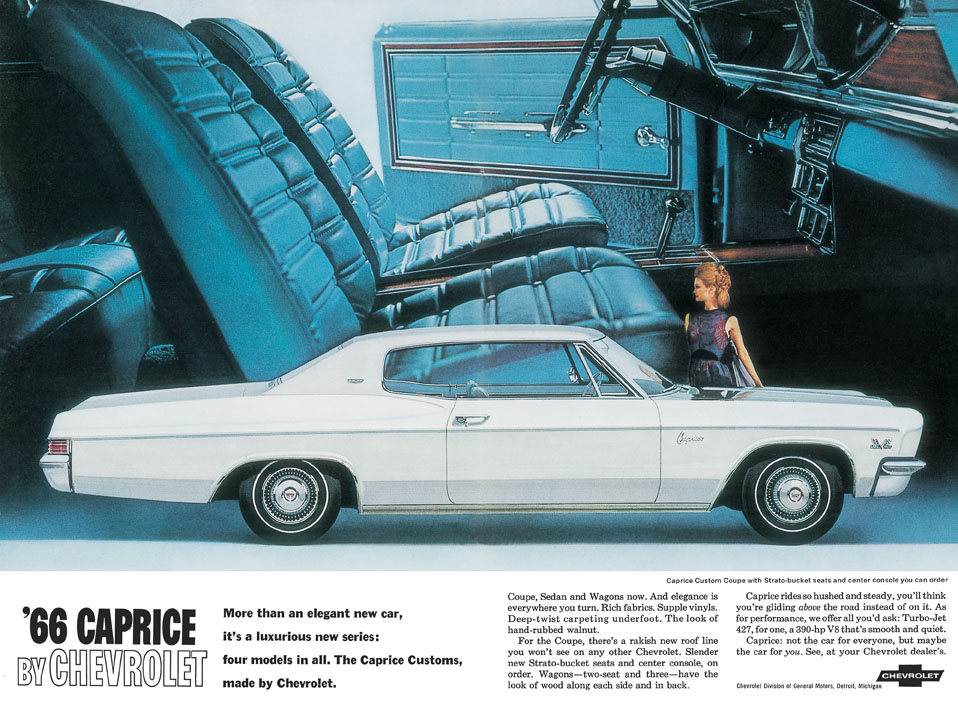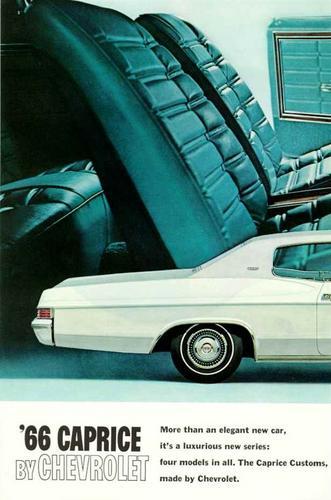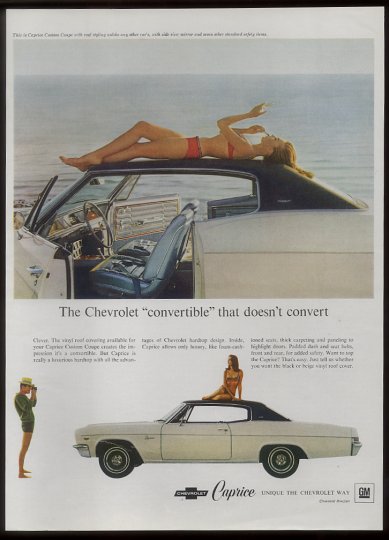

Original advertising for the 1966 Chevrolet Caprice

History of the Chevy Caprice
The Chevrolet Caprice and Caprice Classic were full-sized automobiles produced by the Chevrolet division of General Motors in the United States and Canada from 1965 through 1996 model years and in Mexico from 1977 through 1983.
Throughout its life, the Caprice was the most expensive and luxurious model in the Chevrolet full-size car range, which during its lifetime also included the Biscayne, Bel Air and Impala. Its exit without replacement after the 1996 model year would leave the Ford Crown Victoria, and its cousins the Mercury Grand Marquis and Lincoln Town Car, as the only traditional full-size American sedans.
1965-68
| Production | 1965-1970 |
|---|---|
| Assembly | Arlington, Texas Oshawa, Ontario South Gate, California |
| Body style(s) | 2-door coupe 4-door sedan 4-door station wagon |
| Engine(s) | 283 cu in Small-Block V8 327 cu in Small-Block V8 396 cu in Big-Block V8 427 cu in Big-Block V8 454 cu in Big-Block V8 307 cu in Small-Block V8 350 cu in Small-Block V8 400 cu in Small-Block V8 |
| Transmission(s) | 4-speed manual 3-speed manual 2-speed automatic 3-speed automatic |
| Related | Buick LeSabre Chevrolet Impala Oldsmobile 88 Pontiac Bonneville |
The Caprice began life in mid-1965 as a luxury trim package for the Impala four-door hardtop sedan. This included a stiffer suspension, higher-grade cloth and vinyl seat and door trim (as well as thicker, higher-grade carpeting), walnut trim on the dashboard and door panels, pull straps on the doors, extra convenience lights, special full wheel covers and an optional vinyl top. The name for the Chevrolet Caprice was coined by Bob Lund (Chevrolet's General Sales Manager) after a classy restaurant he frequented in New York City. However, some say the Caprice was named after Caprice Chapman, daughter of auto executive and influential Indy-car official James P. Chapman.
The Caprice was very well received during its abbreviated first year in 1965. For 1966, the Caprice was expanded into a full top-line series to also include a two-door hardtop with a squared-off formal roofline (in contrast to the Impala/SS coupe's fastback roof) and a station wagon with simulated wood exterior trim - the first Chevy "woody" wagon since 1954. A V8 engine was installed in every Caprice. While features such as an automatic transmission, power steering, white sidewall tires, and vinyl top were extra-cost options, virtually every Caprice was sold with them. It is interesting to note, however, that a few Caprices were ordered with the optional 4-speed manual transmission, few or no power accessories, and the 425 hp (317 kW) 427 cubic-inch Turbo Jet V8. However most customers frequently ordered more civilized, but still powerful V8 engines such as the 325 hp (242 kW) 396 cubic-inch Turbo Jet V8 to handle multitudes of luxury options such as air conditioning, power windows, Cruise-Master speed control, power seats and stereo radios; several automotive history books noted that a fully-optioned Caprice rivaled the appearance, comfort and convenience of the Cadillac Deville (which ironically was based on the Caprice and other B-body GM cars, but on a larger and more expensive C-body).
The 1966 Caprice received only minor detail changes from its 1965 predecessor that included a revised grille and new rectangular taillights which replaced the Chevrolet-traditional triple round tailights used in full-sized cars each year since 1958 with the exception of the bat-winged '59 model. New options for 1966 included the automatic "Comfortron" air conditioning system on which the driver could set a constant year-round temperature reading and a "Tilt and Telescopic" steering wheel that could be adjusted vertically in six positions as well as be telescoped further out from the steering column for improved driver comfort.
The Caprice sedan and coupe came standard with a luxurious cloth and vinyl bench seats with a folding center armrest in the rear seat. Optional on both models was a Strato bench seat which combined bucket-style seatbacks and center armrest with a bench cushion for six-passenger seating. Coupes could also be ordered with an all-vinyl interior featuring Strato bucket seats and center console with floor shifter, storage compartment, courtesy lighting and full instrumentation at the front end of the console that was integrated with the lower instrument panel - in essence a more luxurious Impala SS in a formal-roofed bodyshell. Station wagons featured an all-vinyl bench seat interior.
Here is the first picture of my car. I wasn't looking for a car at the time and drove past it a few times, but I couldn't get it out of my mind. I just had to have it. I ended up calling the owner the next day to take a look at it. After taking it for a drive...I just had to have it.